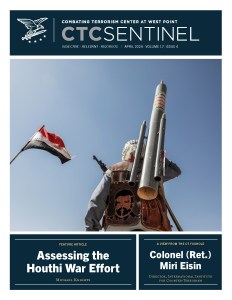From the Editor
In this month’s feature article, Michael Knights provides a highly detailed assessment of the six-month Houthi war effort that has seen the Tehran-backed group launch missiles at Israel and attack shipping off the coasts of Yemen. He assesses that: “The Houthis have used the Gaza crisis to vault into the front ranks of the Iran-led ‘Axis of Resistance,’ arguably as the only axis partner to truly globalize the conflict through their anti-shipping attacks on the approaches to the Suez Canal. The movement has demonstrated boldness—as the first axis member to fire ballistic missiles at Israel—and resilience in the face of U.S.-U.K. airstrikes. The Houthis are likely to emerge from the war as a more confident, ambitious, and aggressive terrorist army, with a taste for provocative and eye-catching acts of defiance against Israel and the United States.”
Our interview is with Colonel (Ret.) Miri Eisin, the director of the International Institute for Counter-Terrorism (ICT) at Reichman University who previously served in a variety of senior intelligence roles in the Israel Defense Forces (IDF). She stresses the need to learn lessons from the intelligence failures that preceded the Hamas-led October 7 attack so that Israel is not surprised again, for example with regard to the kind of threat Hezbollah could pose in the coming months. “All of us made wrong assumptions, and the combination of all of them brought about a colossal failure,” she says. “We collectively were wrong about the capability. We were wrong about the intentions. We were wrong about the ferocity.”
Kévin Jackson assesses the current state of al-Qa`ida Central. He writes that “while the challenges facing the group are real, it should not be written off, as it has proved time and again more resilient than expected.” He adds that “in the wake of the Gaza war, al-Qa`ida likely feels emboldened by what it perceives as a uniquely auspicious geopolitical context to further its global ambitions.”
The African Union is set to withdraw the remainder of its forces from Somalia by December 31, 2024. Paul Williams evaluates whether the Somali National Army (SNA) or al-Shabaab would be stronger militarily if this happens. He writes that “the SNA would retain an advantage in terms of size, material resources, and external support but performs poorly on non-material dimensions and would remain dependent upon external finance and security assistance. Overall, however, al-Shabaab would be slightly militarily stronger because of its significant advantages across the non-material dimensions related to force employment, cohesion, and psychological operations, as well as the sustainability of its forces.”
Paul Cruickshank, Editor in Chief
 Skip to content
Skip to content

